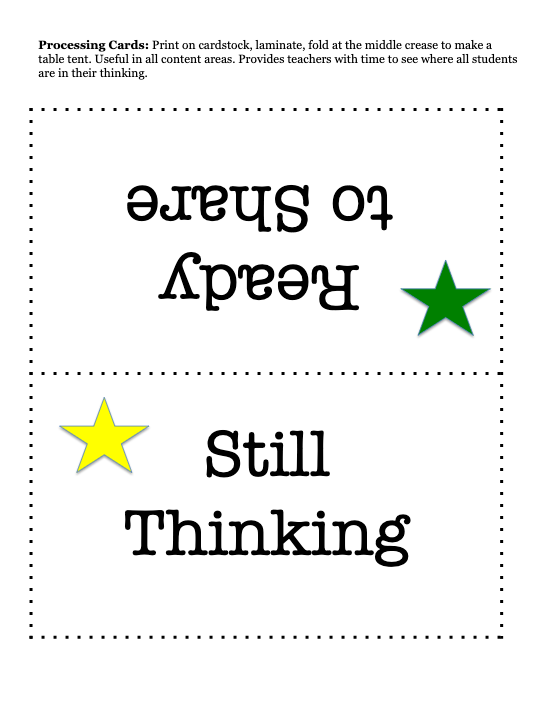Thumbs Up When Ready & Processing Cards
What It Is
Allowing students to take even a brief moment to process their reflections to a prompt is critical if you want to get high quality responses, especially if you have students with certain special needs or English language learners in your class. Here are two ways to read each individual’s progress as the students process their reflections. Both techniques also serve as great unspoken reminders to students that they should all be in the process of reflecting on the prompt.
Thumbs Up is useful for quick activities in which the wait time between the beginning and end of the processing might be as short as two or three minutes. The Processing Cards are useful for activities that take significantly longer, especially when a final wrap-up activity depends on all students having completed a certain task.
How It Works
Thumbs Up When Ready
- Ask students to reflect on your prompt.
- Explain that when they have a thought or are finished, they should put their thumb up as an indication that they are ready to move on.
- Add a Pair-Share to allow time for students to share what they know.
Processing Cards
- Give students Processing Cards. These can be index cards, laminated cards, or printed paper folded into “tents” that on one side say “Still Thinking” with a yellow highlight or picture of a yellow circle or square, and on the other side say “Ready to Share” with a green highlight or a picture of a green circle or square.
- Ask students to place the card on the edge of their desk, with the side that says “Still Thinking” facing up or out.
- As soon as students have completed their task, they should flip the card over so that the side that says “Ready to Share” is facing out of up.
- Decide on an in-between activity that gives students who finish early an opportunity to apply or extend their learning.
How to Ensure Higher-Order Thinking
Your prompt or task will determine whether or not this activity requires lower-order or higher-order thinking skills. Ask students to justify their responses and to give the basis for their justification. For example, are they justifying responses based on personal experiences or learned concepts? Depending on the activity, both may be valid.

Source
Himmele P., and Himmele, W. Total Participation Techniques: Making Every Student an Active Learner. ASCD, 2017, pp.50-52.